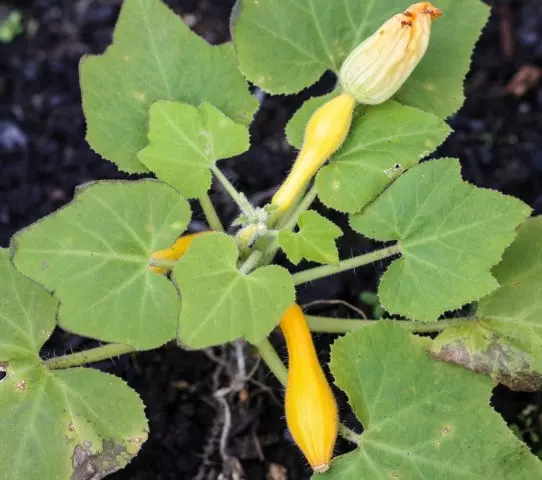Yellow leaves on zucchini squash plant may be a recurrent problem when growing squash or zucchinis. Yellow leaves on squash plants can be caused by several different factors. What causes squash leaves to turn yellow. Some common causes of yellow leaves on squash plants are nutrient deficiencies, water issues, and pests.
The first step to determining what causes yellow leaves on squash plants is to take note of the other plant leaves. If all the leaves are turning yellow then it is probably a nutrient deficiency or water issue. If only some of the leaves are turning yellow on the squash plant then it is likely due to pests or disease. Let’s see what causes squash leaves to turn yellow.
Table of Contents
Squash Yellow Leaves – Squash Care Tips
Firstly, for a good diagnosis of what causes yellow leaves on squash plants, you should review the following care tips this plant needs.
Overwatering, lack of sun, and lack of nutrients are common causes of yellowing leaves on squash and any plants.
Being a plant that develops quite a lot, the distance between squash plants must be large. Although it is possible to grow squash on a trellis to make the most of the space in our garden, an ideal separation between plants will be between 35” and 40” (90 cm and 100 cm). Therefore, check out the space between squash plants, otherwise, the lack of sun reaching the leaves will cause the yellow leaves on squash plants.
Recommended article How to grow zucchini on a trellis
As the main care what I do is trellising and pruning the squash plant to improve the aeration of the plant and fungi do not affect me.
Squashes are a crop that requires little care and with good watering can give us a great harvest. Watering should be regular to avoid water stress in the plant that can even cause the flowers to fall without forming fruit.
When the squash plant begins to form fruit, we should try to increase the amount of water per irrigation. Always be careful not to flood the soil because it can rot the fruits or even lead to the appearance of fungi. Overwatering causes yellowing leaves on squash.
Yellow Leaves on Squash Plants
Yellow leaves on Squash Plants. Squash plants are one of the most prolific and easy-to-grow crops. They grow quickly and easily in the garden, especially on a trellis, guided by our help.
However, it can happen that at some point yellow leaves, yellow spots on leaves, and even yellow and curled leaves appear on the squash plant. These chlorotic leaves can appear for different reasons.
Below you will find out what causes yellow leaves in squash, how to solve it, and how to prevent it for future squash crops. Let’s move on and see What causes squash leaves to turn yellow.
Yellowing Leaves on Squash Due to Lack of Sun
Yellowing leaves on Squash Due to Lack of Sun. Sunshine is essential for the development of squash.
Squash requires a lot of sunlight to grow and develop properly. You should place squash in a place where they receive at least six hours of direct sunlight, ideally eight hours.
To avoid having yellow leaves on squash plants due to lack of sunlight, you should choose the right place to plant your squash to make sure it gets enough sunlight.
If you have already planted the squash and it did not grow much, you could transplant it to a sunnier place.
You can also plant the squash in a large pot and then move it to the best spot with plenty of sunlight. If the squash gets enough sunlight, squash will not have problems with yellow leaves.
Yellowing Leaves on Squash Due to Watering
Yellowing leaves on Squash Due to Watering. Squash is a plant that consumes a lot of water and the soil must therefore be able to meet this high demand. Either through rainwater, irrigation, or, more often, both. Overwatering causes yellow leaves on squash plants.
Depending on the type of soil in question, it will be necessary to act in one way or another to ensure that constant humidity is maintained near the squash plant.
In general, it is advisable to make frequent irrigations of low intensity – a few liters/gallons at a time. Although, as we said, this will depend on the type of soil and the climate.
In soils rich in organic matter or clay, watering should be less frequent because this type of soil retains more water.
On the other hand, in soils that retain almost no water (sandy), watering should be very frequent and of very low intensity. Since they retain so little water, whatever we overwater will be lost in the deeper layers.
That is why we must water the squash plant correctly, as overwatering will rot the roots and insufficient watering will dry it out due to lack of water. Inadequate watering will produce yellow leaves on squash.
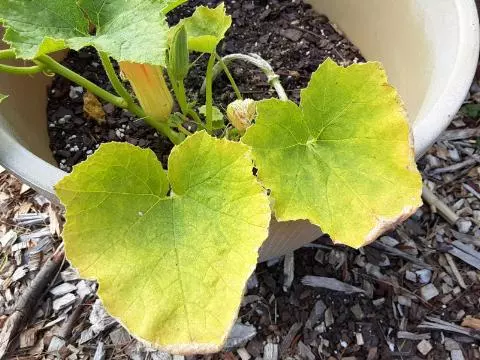
Yellowing Leaves on Squash Due to Nutrient Deficiencies
Yellowing leaves on Squash Due to Nutrient Deficiencies. Squash needs a certain amount of nutrients to develop properly. A lack of nutrients will cause the squash to have yellow leaves on squash plants.
We recommend always checking the quality of the soil before planting squash.
Squash plants adapt quite well to soils with pH values between 5 and 7, but prefer slightly acidic soils, with average values between 5.6-6.8.
With basic pH, deficiency symptoms may appear, but they can be corrected with macro and microelements. First, measure the soil pH and see if needed to be corrected.
Squash crops need nutrients to develop properly, without the necessary nutrients the squash plant will not develop properly and will be more susceptible to pests and diseases.
Yellow leaves on Squash Plants Due to Lack of Nutrients. Iron and calcium deficiency are the most common nutrient deficiency in plants that cause yellow leaves on squash plants. If the squash plant has the necessary nutrients it will not have problems with yellow leaves.
With a 4-4-4 or 4-6-4 fertilizer, squash plants will have the necessary nutritional supply for correct growth. A 4-4-4 fertilizer means Nitrogen-Phosphorus-Potassium or NPK is 4-4-4. In this article about types of fertilizers, we explain more about this terminology and how to choose correctly.
Squash plants need fertilization twice during the life cycle. The first fertilization is before planting or sowing the squash seeds while preparing the soil to place the seeds. The second fertilization needed is when the squash plant is blooming.
Yellowing leaves on squash due to lack of nutrients is easy to fix by adding a suitable fertilizer for the squash plant. I recommend removing the yellow leaves on the squash plant and verify the soil pH is suitable for the plant.
How to fix yellowing leaves on squash plants due to a lack of nutrients? We recommend adding twice per cycle a suitable organic fertilizer NPK 4-4-4 like the one below.
- Package contains 4 Pounds organic all purpose plant fertilizer grains and is produced to avoid wasteful runoff, mess, hazards and smells
- Plant fertilizer is formulated with a 4-4-4 NPK to provide vegetables, plants, and flowers nutrients they need for a high yield and vibrant foliage
- Jobe's organic fertilizer contains no synthetic chemicals and are OMRI listed for organic gardening by the USDA
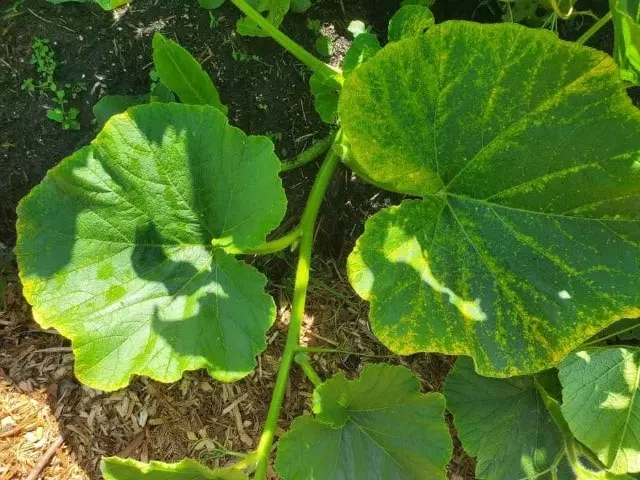
Yellowing leaves on squash Due to Pests and Diseases
The presence of pests and diseases is one of the most common causes of yellow leaves on squash plants, as in any type of plant.
In the case of squash plants, the leaves are susceptible to infection by bacteria, fungi, and viruses and can also attract certain non-beneficial insects to our gardens such as aphids and spider mites.
In the next paragraphs, we will review what causes yellow leaves on squash plants related to pests and diseases and how to fix yellowing leaves and prevent them.
Yellow Leaves on Squash Plants Due to Bacteria Pseudomonas syringae (Angular spot of Cucurbitaceae)
Yellow Leaves on Squash Plants Due to Bacteria Pseudomonas syringae. The angular leaf spot of Cucurbits is caused by the bacteria Pseudomonas syringae. The disease caused by the bacteria Pseudomonas syringae begins to appear in yellowing squash leaves.
The first sign of the infection with Pseudomonas syringae is yellow spots on squash leaves.
Yellow spots appear on squash leaves and progress turning yellow the entire leave. It affects Cucurbitaceae (squash, zucchini, melon, watermelon, pumpkin). The yellow spots on squash leaves spread until they are delimited by the nerves of the leaves.
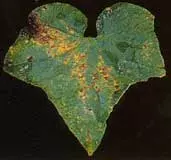
How to Prevent Yellow Leaves Caused by Pseudomonas syringae
How to Prevent Yellow Leaves Caused by Pseudomonas syringae
- It is recommended to use healthy squash seeds, of good commercial quality and sterile (if possible).
- Preserve squash seeds by controlling the environmental humidity. Avoid excess humidity in the environment.
- When the first symptoms of yellow leaves are observed, remove diseased leaves and plants. Do not use these leaves and plants in compost. Discard them to eradicate the bacteria and prevent infecting other nearby crops.
- There is no chemical treatment to eradicate this bacteria. However, copper fungicide prevents the disease caused by Pseudomonas syringae.
- Control fungus and disease in your garden with Captain Jack’s Liquid Copper Fungicide Concentrate!
- Approved for organic gardening, this fungicide is suitable for the production of organic produce and can even be used up until the day of harvest!
- Copper Fungicide effective in the control and prevention of a wide range of plant diseases. Listed common garden diseases include blight, black spot, powdery mildew peach leaf curl and more.
Yellow and Curled Leaves on Squash Plants Due to Mosaic Virus ZYMV
Yellow and Curled Leaves on Squash Plants Due to Mosaic Virus ZYMV. One of the most commercially important viruses in cucurbit crops is the Zucchini Yellow Mosaic Virus (ZYMV) causing initially yellowing leaves on squash.
The ZYMV is producing severe disease (mosaicism), blistering of the leaf lamina, deformity, and knobbed fruits, as well as a wide range of biological diversity.
Cucurbita pepo‘s summer crop and the winter squashes Cucurbita maxima and Cucurbita moschata are all affected by the ZYMV.
Cucurbits species are susceptible to diseases that attack roots, foliage, and fruit. Zucchini yellow mosaic virus (ZYMV) is a common viral pathogen that reduces the quality and yield of squash and the other crops it can affect (see reference).
What causes yellow leaves on squash plants? Infection with the Zucchini yellow mosaic virus (ZYMV) is manifested by the initial appearance of yellow and curled leaves on squash plants.
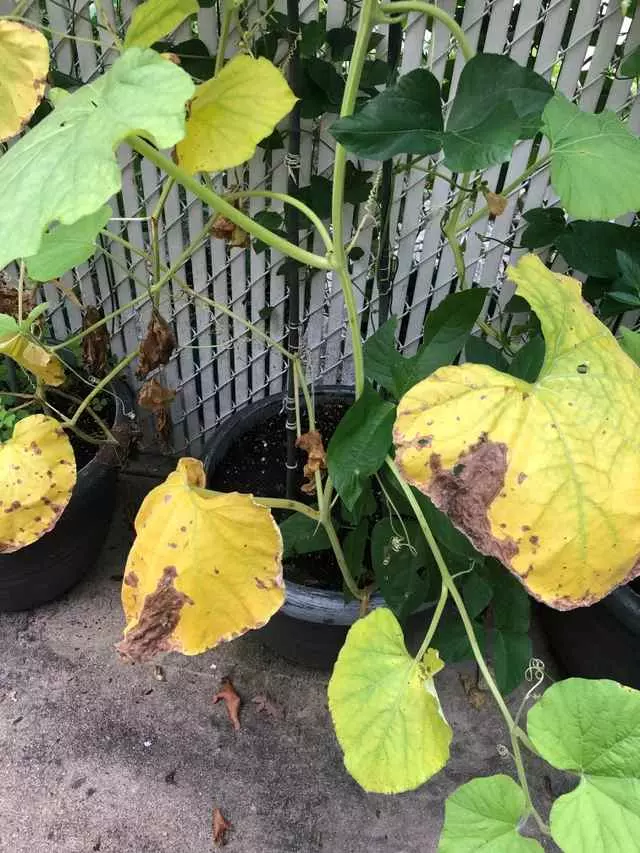
Therefore, a key sign to understand if the squash plant is diseased with mosaicism or not is to look at the leaves. You will observe that the squash leaves turn yellow and also that they become curved and take on the appearance of twisted leaves.
A major drawback of squash plant infection caused by ZYMV is that it spreads very rapidly to other surrounding crops.
While not all plants can be affected by this virus, other crops such as melons, watermelons, and all types of squash can be infected. It is easily transmissible to a wide range of hosts and is transmitted by 26 aphid species in a non-persistent manner (see reference).
How to Fix Yellow and Curled Leaves on Squash Plants Due to Mosaic Virus ZYMV
How to Fix Yellow and Curled Leaves on Squash Plants Due to Mosaic Virus ZYMV. Unfortunately, it is not possible to cure the plant. But we can stop the progress of the disease and protect the crops around the infected squash with yellow leaves.
Aphids spread the disease when they feed on the underside of the plant’s leaves. The mosaic virus is transmitted by aphids, resulting in stunted growth that is evidenced by yellowed and curved leaves on squash plants and causes poor fruit development.
As mentioned earlier, once the plant is infected, there is no cure.
However, we can try to stop the progress of the disease by removing and destroying any infected plant parts. Do not use the removed plants or leaves in any compost. All of it is diseased and should be disposed of to avoid new infections.
In addition, it is advisable to check the plants, stems and behind the leaves for aphids. As always mentioned, at the first sign of aphids, immediately treat your plants with insecticidal soap and neem oil for plants.
Yellowing Leaves on Squash Due to Spider Mites
Yellowing Leaves on Squash Due to Spider Mites. Another insect pest that can cause yellow leaves on squash is spider mites.
Spider mites suck sap from the plant’s leaves, which causes squash leaves to turn yellow.
How to Fix Yellow Leaves on Squash Plants Due to Spider Mites
How to Fix Yellow Leaves on Squash Due to Spider Mites. Here is the step-by-step to eliminate yellow leaves in squash plants due to spider mites:
- Treat the plants with neem oil.
- Spray the entire leaves, including the underside. You can check here our video on how to prepare and apply neem oil for plants.
- When there are recurrent problems with spider mites a possible ecological solution is to introduce or encourage ladybugs that will feast on spider mites (and aphids too).
- This is only recommended as a preventative measure. If you already see yellow leaf damage and the presence of spider mites, encouraging the use of ladybugs will not be effective in correcting the problem.
Yellowing Leaves on Squash Due to Fusarium Wilt
Why Are The Leaves On My Squash Plants Turning Yellow – Fusarium Wilt
Another disease that can result in squash plants with yellow leaves is caused by the mold Fusarium and it is named Fusarium Wilt.
This fungal disease affects the vascular tissue of the plant. The spores live in the soil and can be carried by beetles.
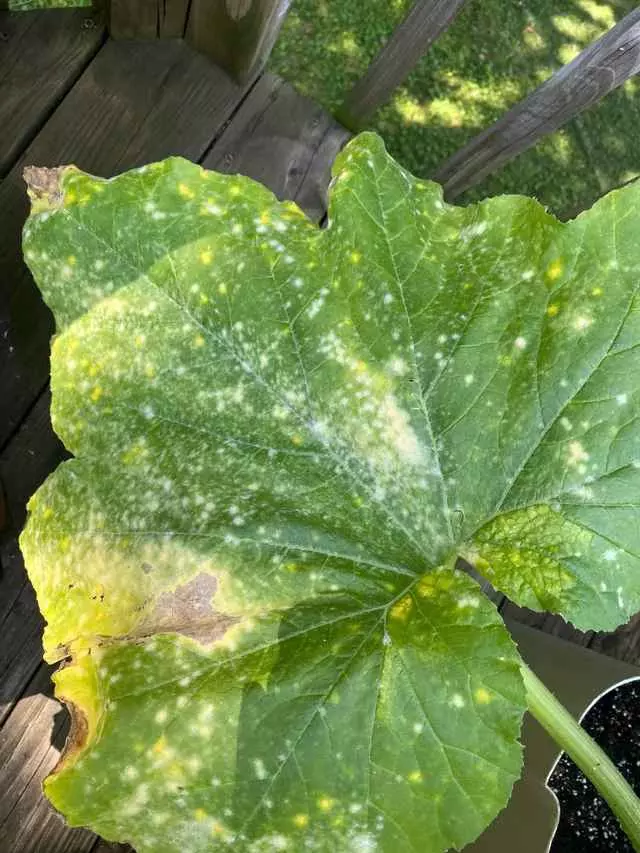
How to Fix Yellow Leaves on Squash Due to Fusarium Wilt
How to Fix Yellow Leaves on Squash Due to Fusarium Wilt. Unfortunately, once the plant is infected, fungicides are ineffective. It is best to remove and destroy infected plants. Again, we recommend not using any part of the infected plants for composting.
Even if the plants are completely removed, the soil should be treated with fungicide to prevent the spread of Fusarium spores to other crops and to eradicate their presence from the soil for your future crops and harvests.
